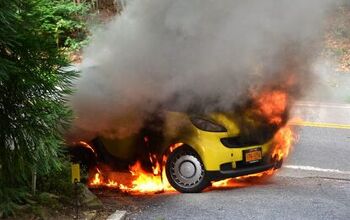Smart Summon a Smart Idea? The NHTSA Wants to Know

For some strange reason, U.S. road safety regulators are showing an interest in a Tesla feature that allows driverless vehicles to navigate tight, crowded public spaces on their own — one Tesla admits “may not detect all obstacles.”
Clearly, by investigating reports of Tesla’s Smart Summon feature going awry, the National Highway Traffic Safety Administration is standing in the way of progress, or so some brand diehards would have you believe. To others, the agency’s scrutiny is overdue.
The NHTSA announced it was poring into reports of Smart Summon fails on Wednesday evening, nearly a week after Tesla’s latest software update delivered the feature to owners who opted for the Full Self Driving package at purchase time.
While Tesla CEO Elon Musk claims owners used the feature over half a million times within a few days, it’s the less-successful parking lot forays that the NHTSA’s worried about.
Designed to be used as a valet service in private parking lots and driveways, Smart Summon navigates the Tesla at low speeds to the owner’s location, with the car using the owner’s phone as a homing beacon. Users are warned to use the feature when no more than 200 feet from the car, and only when the vehicle is within their line of sight. As we showed you Saturday, those early experiments were not without drama.
One Model 3 nearly collided with an Acura MDX in a crowded parking lot, only coming to a halt after the owner took his finger off the phone app’s summon button. Another hit a garage wall in a video uploaded by the owner, while one owner claims their Tesla made contact with a vehicle that was in the process of backing up. Yet another video showed a Tesla that was unable to differentiate asphalt from grass.
As reported by Reuters, the NHTSA claims it “is aware of reports related to Tesla’s Summon feature. We are in ongoing contact with the company and we continue to gather information. Safety is NHTSA’s top priority and the agency will not hesitate to act if it finds evidence of a safety-related defect.”
Tesla issued the feature with appropriate warnings about owner vigilance and proper use, but the mere fact the feature exists — and could fall into the hands of a not-so-vigilant owner — is legitimate cause for concern. Just because the automaker tells users to be “especially careful around quick moving people, bicycles and cars” does not mean people will. Were a collision to happen, there’d be no one behind the wheel. Who’s at fault — the user, or the company behind the self-driving parking lot denizen?
You can be sure lawyers are salivating at the thought of seeking a pound of flesh from Tesla.
[Image: Tesla]

More by Steph Willems
Latest Car Reviews
Read moreLatest Product Reviews
Read moreRecent Comments
- Varezhka Maybe the volume was not big enough to really matter anyways, but losing a “passenger car” for a mostly “light truck” line-up should help Subaru with their CAFE numbers too.
- Varezhka For this category my car of choice would be the CX-50. But between the two cars listed I’d select the RAV4 over CR-V. I’ve always preferred NA over small turbos and for hybrids THS’ longer history shows in its refinement.
- AZFelix I would suggest a variation on the 'fcuk, marry, kill' game using 'track, buy, lease' with three similar automotive selections.
- Formula m For the gas versions I like the Honda CRV. Haven’t driven the hybrids yet.
- SCE to AUX All that lift makes for an easy rollover of your $70k truck.


































Comments
Join the conversation
Those videos look more like an Alpha test...that stuff isn't even Beta test level.
RE: The lede photo. Viewing the image of a dashboard without gauges, buttons, or dials prompts me to feel an involuntary nostalgic flashback to the days when cars were not mobile computer terminals.